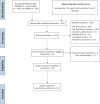The Role of Resistance Training Dosing on Pain and Physical Function in Individuals With Knee Osteoarthritis: A Systematic Review
- PMID: 31850826
- PMCID: PMC7040944
- DOI: 10.1177/1941738119887183
The Role of Resistance Training Dosing on Pain and Physical Function in Individuals With Knee Osteoarthritis: A Systematic Review
Abstract
Context: Dosing parameters are needed to ensure the best practice guidelines for knee osteoarthritis.
Objective: To determine whether resistance training affects pain and physical function in individuals with knee osteoarthritis, and whether a dose-response relationship exists. Second, we will investigate whether the effects are influenced by Kellgren-Lawrence grade or location of osteoarthritis.
Data sources: A search for randomized controlled trials was conducted in MEDLINE, Embase, and CINAHL, from their inception dates, between November 1, 2018, and January 15, 2019. Keywords included knee osteoarthritis, knee joint, resistance training, strength training, and weight lifting.
Study selection: Inclusion criteria were randomized controlled trials reporting changes in pain and physical function on humans with knee osteoarthritis comparing resistance training interventions with no intervention. Two reviewers screened 471 abstracts; 12 of the 13 studies assessed were included.
Study design: Systematic review.
Level of evidence: Level 2.
Data extraction: Mean baseline and follow-up Western Ontario and McMaster Universities Osteoarthritis Index (WOMAC) scores and standard deviations were extracted to calculate the standard mean difference. Articles were assessed for methodological quality using the CONSORT (Consolidated Standards of Reporting Trials) 2010 scale and Cochrane Collaboration tool for assessing risk of bias.
Results: The 12 included studies had high methodological quality. Of these, 11 studies revealed that resistance training improved pain and/or physical function. The most common regimen was a 30- to 60-minute session of 2 to 3 sets of 8 to 12 repetitions with an initial resistance of 50% to 60% of maximum resistance that progressed over 3 sessions per week for 24 weeks. Seven studies reported Kellgren-Lawrence grade, and 4 studies included osteoarthritis location.
Conclusion: Resistance training improves pain and physical function in knee osteoarthritis. Large effect sizes were associated with 24 total sessions and 8- to 12-week duration. No optimal number of repetitions, maximum strength, or frequency of sets or repetitions was found. No trends were identified between outcomes and location or Kellgren-Lawrence grade of osteoarthritis.
Keywords: knee joint; knee osteoarthritis; resistance training; strength training; weight lifting.
Conflict of interest statement
The authors report no potential conflicts of interest in the development and publication of this article.
Figures
References
-
- Baker KR, Nelson ME, Felson DT, Layne JE, Sarno R, Roubenoff R. The efficacy of home based progressive strength training in older adults with knee osteoarthritis: a randomized controlled trial. J Rheumatol. 2001;28:1655-1665. - PubMed
-
- Bennell KL, Hunt MA, Wrigley TV, et al. Hip strengthening reduces symptoms but not knee load in people with medial knee osteoarthritis and varus malalignment: a randomised controlled trial. Osteoarthritis Cartilage. 2010;18:621-628. - PubMed
-
- Centers for Disease Control and Prevention. Prevalence and most common causes of disability among adults—United States, 2005. MMWR Morb Mortal Wkly Rep. 2009;58:421-426. - PubMed
-
- Chaipinyo K, Karoonsupcharoen O. No difference between home-based strength training and home-based balance training on pain in patients with knee osteoarthritis: a randomised trial. Aust J Physiother. 2009;55:25-30. - PubMed
Publication types
MeSH terms
LinkOut - more resources
Full Text Sources
Medical
Research Materials


